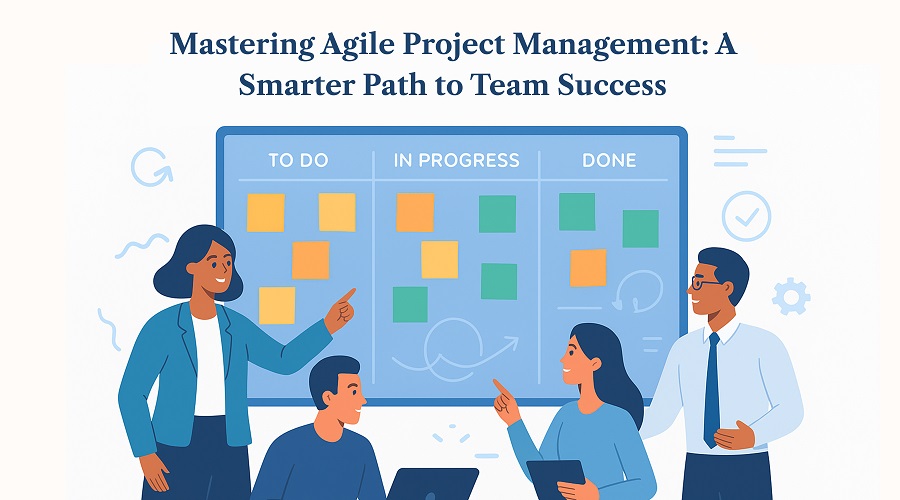In today’s fast-paced, ever-evolving business world, project teams face mounting pressure to deliver faster, better, and more efficiently. That’s where Agile Project Management steps in not just as a methodology, but as a mindset shift. Agile empowers teams to adapt quickly, embrace change, and drive results with laser focus. But what exactly is it, and why are top-performing companies across industries making the Agile switch? Let’s dive deep.
What is Agile Project Management?
Agile Project Management is an iterative, team-centric approach to planning and guiding project processes. Unlike traditional methods that follow a strict, linear path (like Waterfall), Agile emphasizes flexibility, collaboration, and customer feedback throughout the project lifecycle.
At its core, Agile is about delivering value in small, workable increments allowing teams to adapt and pivot as needed. The most popular frameworks under the Agile umbrella include Scrum, Kanban, and Lean. Each has its nuances, but they all follow the same principle: responding to change over following a rigid plan.
Why Agile Works: Key Benefits
1. Flexibility in a Changing Environment
Markets change. Customer expectations shift. Agile Project Management gives teams the ability to roll with the punches, revising priorities as new insights emerge. Unlike fixed-scope models, Agile thrives on adaptability making it ideal for innovation and software-driven projects.
2. Increased Stakeholder Engagement
Agile encourages continuous collaboration. Whether it’s weekly sprints, daily stand-ups, or sprint reviews, stakeholders remain looped in from start to finish. This means fewer surprises and more alignment.
3. Faster Time-to-Market
Agile teams deliver usable features or iterations early and often. This rapid cycle allows businesses to go live sooner, test ideas faster, and gain competitive advantages.
4. Better Risk Management
Agile’s incremental nature means potential issues are spotted and addressed early long before they escalate into costly problems. This minimizes risk and ensures a smoother delivery process.
Core Components of Agile Project Management
To successfully implement Agile, you’ll want to embrace its key elements:
Sprints
Short, time-boxed periods (usually 1–4 weeks) where teams complete a set amount of work. Sprints create momentum and help maintain focus.
Scrum Roles
- Product Owner: Defines project vision and prioritizes the backlog.
- Scrum Master: Facilitates team communication and removes roadblocks.
- Development Team: Executes the work and delivers value.
Backlogs
A prioritized list of features, tasks, and improvements. Agile backlogs are dynamic constantly evolving based on feedback and results.
Daily Stand-Ups
Quick, 15-minute meetings where team members share progress, plans, and blockers. These keep communication flowing and projects on track.
When (and When Not) to Use Agile
Agile Project Management is excellent for:
- Software development
- Marketing campaigns
- Product launches
- Any project with evolving goals or uncertainty
- However, it might not be the best fit for:
- Projects with fixed budgets and timelines
- Highly regulated industries where every change requires documentation
- Teams unfamiliar or untrained in Agile principles
Hybrid approaches (Agile + Waterfall) are becoming more common in such scenarios.
Transitioning to Agile: Tips for Success
Shifting to Agile isn’t just a procedural change it’s cultural. Here’s how to make the shift smoother:
- Train Your Teams: Invest in Agile certifications and workshops.
- Start Small: Pilot Agile in one team or department.
- Use the Right Tools: Platforms like Jira, Trello, and Asana support Agile workflows.
- Encourage Collaboration: Break silos and foster open dialogue.
- Be Patient: True Agile transformation takes time but the results are worth it.
Final Thoughts: Agile as a Long-Term Strategy
Agile Project Management isn’t just about delivering faster it’s about delivering smarter. It brings transparency, boosts team morale, and keeps the end-user at the heart of every decision. Whether you’re managing a tech startup or transforming a corporate workflow, embracing Agile can elevate your team’s productivity and innovation potential.
Unlock your full potential with our research support and PhD help services designed for academic excellence. Let us guide you toward smarter strategies and greater success in your academic and professional journey.
FAQs About Agile Project Management
Q1: What’s the difference between Scrum and Agile?
A: Agile is a broad philosophy of project management, while Scrum is one of the specific frameworks that follows Agile principles. Think of Agile as the mindset and Scrum as a structured way to apply it.
Q2: Can Agile be used outside of software development?
A: Absolutely. Agile has been successfully adopted in marketing, education, product design, HR, and more. Its adaptability makes it suitable for any project that values iteration and feedback.
Q3: How do I measure success in Agile projects?
A: Success is typically measured through working software (or deliverables), velocity, stakeholder satisfaction, and how well the product meets user needs not just hitting deadlines.
Q4: Is Agile more expensive than traditional project management?
A: Not necessarily. While Agile may appear costlier upfront due to more meetings and initial training, it often saves money long-term by reducing rework and improving quality.
Q5: Do we need a Scrum Master for every Agile team?
A: While not mandatory, having a dedicated Scrum Master significantly improves Agile adoption by removing blockers and ensuring the team adheres to best practices.





Comments